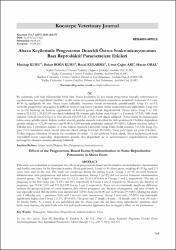Abaza keçilerinde progesteron destekli östrus senkronizasyonunun bazı reprodüktif parametrelere etkileri
Abstract
Bu çalışmada, yerli keçi ırklarımızdan birisi olan Abaza keçilerinin ilk kez olarak progesteron kaynaklı senkronizasyon uygulamasının bazı reprodüktif özellikler ve döl verimi sonuçlarına etkilerinin araştırılması amaçlandı. Çalışmada 2-5 yaşlı, 40-50 kg ağırlığında 40 adet Abaza keçisi kullanıldı. Araştırma üreme mevsiminde gerçekleştirildi. Grup 1’e (n=15) kontrollü progesteron salan aparat (CIDR) ile hormon uygulaması yapılarak östrus senkronizasyonu sağlanırken, Grup 2‘ye ise (n=25) herhangi bir hormon uygulanmadı ve kontrol gurubu olarak değerlendirildi. Östrus süresi Grup 1 ve 2’de sırasıyla 25,1±2,11, 25,4±3,69 saat olarak belirlendi. İlk östrusta gebe kalma oranı Grup 1 ve 2 sırasıyla %73,33, %88 olarak saptandı. Gebelik süresi Grup 1 ve 2’de sırasıyla 153,50±3,21, 151,26±3,89 olarak belirlendi. Östrus süresi, ilk östrusta gebe kalma oranı, gebelik süresi, doğum saatleri arasında gruplar arasında istatistiksel bir fark gözlenmedi. Özellikle doğumların gündüz olduğu ve %72,98 oranında saat 06.00 ile 12.00 arasında görüldüğü saptandı (P<0,001). Çalışma süresince sadece 1 foliküler kist, 1 prematüre doğum ve 1 güç doğum olgusuyla karşılaşıldı. Grup 1'deki ikizlik oranının (%53,34) Grup 2'ye göre (%12) istatistiksel olarak önemli düzeyde yüksek olduğu belirlendi (P=0,005). Yirmi yedi keçide tek yavru (14 erkek - 13 dişi) doğumu izlenirken 10 keçide ikiz yavrulama (10 erkek - 10 dişi) gözlendi. Sonuç olarak, Abaza keçilerinin pek fazla reprodüktif sorun yaşamadığı, doğumlarının gündüz, ikiz doğumların az ve senkronizasyon uygulamalarının üretime herhangi bir olumsuz etkisinin olmadığı belirlendi. This study was undertaken to investigate the effects of progesterone-based synchronization on reproductive characteristics and fertility outcomes for the first time in native Abaza goat breed. A total of 40 Abaza goats, weighing 40-50 kg, aged 2-5 years, were used in the trial. The study was conducted during the mating season. Group 1 (n=15) received hormone administration with progesterone and estrus synchronization. Group 2 (n=25) did not receive hormone administration (control group). The length of estrus was 25.1±2.11 and 25.4±3.69 hours in Groups 1 and 2, respectively. The rate of pregnancy in the first estrus was 73.33% and 88% respectively in Group 1 and 2, respectively. Moreover, the duration of pregnancy was 153.50±3.21 and 151.26±3.89 Group 1 and 2 respectively. There was no statistically significant difference between the groups in terms of estrus duration, first estrous pregnancy rate, duration of pregnancy, and time of birth. It was especially found that the births were daytime and 72.98% between 06.00 and 12.00 hours (P<0.001). During the study, only 1 follicular cyst, 1 premature birth and 1 dystocia were encountered. Group 1 twin ratio (53.34%) was statistically significantly higher than Group 2 (12%) (P=0.005). The goats had 27 single (14 male - 13 female) and 10 twin (10 male - 10 female) births. As a result, it was determined that the Abaza goats did not have many reproductive problems, their births were daytime, the twin births were low and synchronization application has no negative effect on the production.
Source
Kocatepe Veteriner DergisiVolume
10Issue
3Collections
- Cilt 10 : Sayı 3 [14]



















